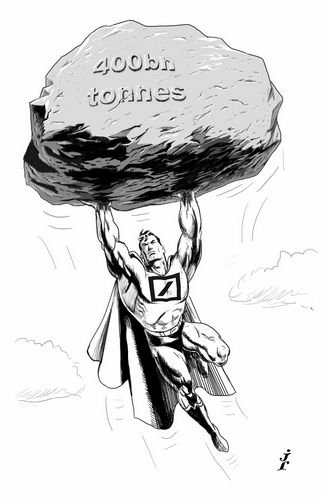A safe pair of hands: As any treasurer will tell you it is a daunting prospect to face a new year with a fresh funding programme and an uncertain market environment. The first months are crucial, and you need a counterparty that is going to show loyalty, innovation and above all else, leadership. Deutsche Bank is IFR’s SSAR Bond House of the Year.
To see the full digital edition of the IFR Review of the Year, please <a href="http://edition.pagesuite-professional.co.uk//launch.aspx?eid=24f9e7f4-9d79-4e69-a475-1a3b43fb8580" onclick="window.open(this.href);return false;" onkeypress="window.open(this.href);return false;">click here</a>.
Cast your mind back to December 2011. Market trepidation was reaching its peak at the thought of a €400bn-plus pipeline of sovereign, supranational, agency and regional supply scheduled for the first quarter of 2012 from Europe alone.
Ratings agencies were sharpening their axes, investors were becoming increasingly disillusioned with the eurozone’s policymakers and banks were facing critical balance sheet restraints. Unparallelled day-to-day market volatility was the new normality.
In such an environment, Europe’s largest issuers needed a safe pair of hands to usher them through a critical first few months. Every single one turned to Deutsche Bank.
After just two weeks of the market reopening, Deutsche had been on the top line for benchmark transactions from the European Financial Stability Facility, the European Investment Bank, the EU and KfW.
From the outset, the pressure was on the bank to deliver a shot of confidence to the market. Against a backdrop of rising anxiety about eurozone rescue efforts, Deutsche led an oversubscribed €3bn inaugural three-year issue from the EFSF. That was the first SSA deal of the calendar year and its success ensured that others would swiftly follow, many of them masterminded by the Deutsche team that included Bill Northfield, Ralph Berlowitz, Achim Linsenmaier and Adrien De Naurois.
A week later, Deutsche ventured into untested waters with a bold €3bn 30-year trade for the EU – which doubled the length of the borrower’s maturity profile.
Before the deal was launched observers worried that its failure could result in a complete dearth of supply in the euro market, and cast a pall over a sector that had been prone to bouts of severe volatility and relative inactivity.
The deal’s overwhelming success allayed those concerns and opened the floodgates for a surge of SSA issuance.
Deutsche’s daring was rewarded by a swathe of mandates that week that included a lucrative €4bn KfW 10-year deal and a €5bn EIB three-year issue.
Auspicious start
That stellar start to the year sowed the seeds for Deutsche to become the most consistent performer across all currencies in 2012. With its global sales network the bank is well positioned to track multiple markets simultaneously, ensuring that for the third year in a row it would receive more lead manager mandates than any of its competitors.
In the euro market, Deutsche relied on its wealth of experience and expertise to win business on most of the year’s landmark deals. With the euro seen as one of the currencies still offering access to long-dated issuance, Deutsche was able to build upon its impressive track record in this area.
The pick of those deals in 2012 had to be Austria’s first ever dual-tranche bond back in January, consisting of a €3bn 10-year and a €2bn 50-year issue. Austria’s 50-year bond still stands as the longest fixed maturity duration product in the euro government bond markets, and was the first 50-year EGB new issue since March 2010. While this was a rare and prestigious offering the timing of the transaction added an additional layer of complexity, coming just a week after Standard & Poor’s downgraded Austria from AAA to AA+.
Deutsche was also involved in Spain’s only syndicated issue of 2012 – a €4bn tap of its 10-year line.
The bank had been part of a working group assessing markets for Spain since 2011. Spain had intended to sell a 10-year syndicated deal post-summer 2011, but it failed to surface as the beleaguered sovereign’s yields rose to alarming levels and real money investors shunned the credit. Its return to markets in early 2012 – a feat that many deemed impossible – was always going to be one of the most fraught funding initiatives of the year. However, with Deutsche at the helm, Spain racked up an €8bn book containing 864 orders of which 80% were from international investors. At the time this event was seen as a very healthy sign for the periphery, but was unfortunately not one they have managed to repeat since.
Global platform
While Deutsche may not hold the top spot in US dollars on a nominal basis it has done more SSAR transactions in the currency than any of its competitors. Not bad for what is traditionally considered a European bank.
Among the many dollar highlights for 2012, Deutsche was involved in a very rare Global issue from Canada (IFR’s SSAR Bond of the Year) which priced at the tightest spread to Treasuries from a sovereign issuer since 2003. Canada’s feat was trumped later in the year by Sweden which priced a new $1bn three-year at a tighter spread – unsurprisingly, a deal Deutsche Bank also arranged.
Compression in dollar swap spreads made it very difficult for issuers to hit sub-Libor funding targets in 2012. Difficult but not impossible.
Deutsche was on hand for IFC’s US$2bn five-year back in April that priced at the tightest level versus mid-swaps for any five-year deal from a supranational since 2008. It also engineered Asian Development Bank’s US$1.25bn three-year issue in May, which achieved its tightest dollar benchmark pricing versus mid-swaps in any tenor since 2008. The European Bank for Reconstruction and Development Bank’s US$1.25bn five-year in August also deserves recognition as its tightest ever pricing versus Treasuries for a Global benchmark.
Outside of the core currencies, Deutsche has risen to the top of the league table in SSAR sterling issuance and is a top three arranger for SSAR bonds in Australian dollars.
In sterling, Deutsche has been able to turn a traditionally unprofitable arbitrage business into a great money-spinner for the bank. As well as repeat mandates from the UK DMO, Deutsche was involved in the largest agency fixed-rate issue in 2012 – Network Rail’s £1.5bn three-year – and Transport for London’s re-entry to public debt markets after a six year absence with a £500m 30-year issue. In the Kangaroo sector, Deutsche Bank led the largest SSA deal of the year – ADB’s A$1.1bn (US$1.15bn) five-year fixed and floater dual-tranche. Deutsche has also cornered the market for some of its other supranational clients, being a joint lead on both of IFC’s Kangaroo offerings in 2012, and leading four issues for the Inter-American Development Bank.
Deutsche’s currency range in 2012 stretches across another nine markets, the pick of which was the first ever “Global” Dim Sum bond for the IFC. The Rmb500m (US$80m) two-year launched in August also marked IFC’s return to the currency after a 19-month absence.
Across core and niche currencies, Deutsche continues to provide its clients with a platform that allows them to tap into new investor bases and achieve the best possible funding cost.
More than that, though, in a year plagued by the ongoing uncertainties in the eurozone, Deutsche has always been entrusted with the most high-profile funding initiatives. Nothing illustrates that better than its role in the world’s largest ever financial transaction – the €206bn debt restructuring for the Hellenic Republic in March 2012. Winning a mandate to act as both the PSI closing agent for the Greek Republic’s debt exchange, and as the sole underwriter for the €35bn EFSF cash “sweetener”, illustrates, better than anything, the esteem with which the bank is held in sovereign debt markets.



